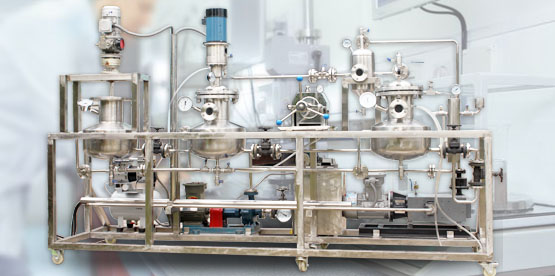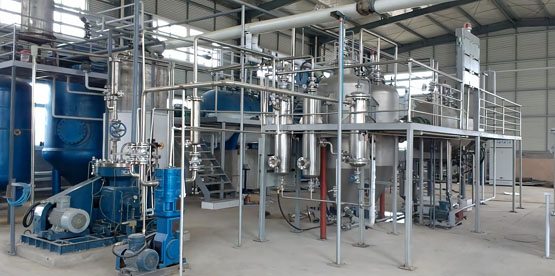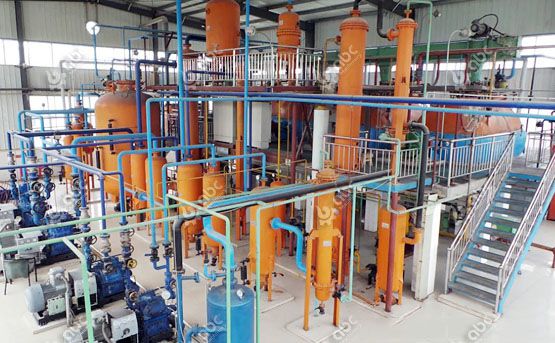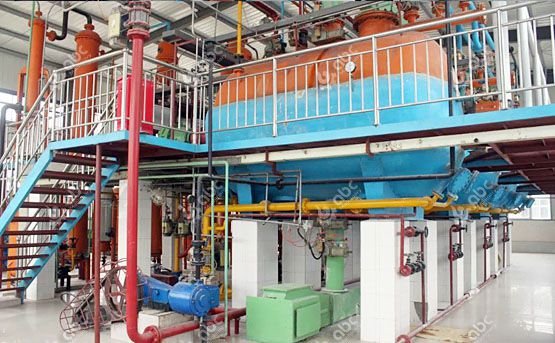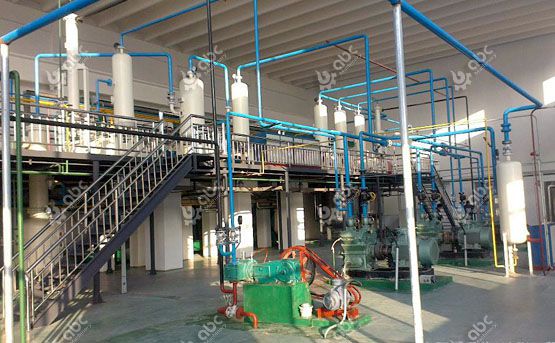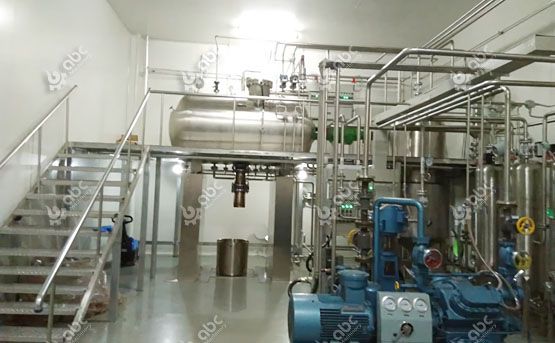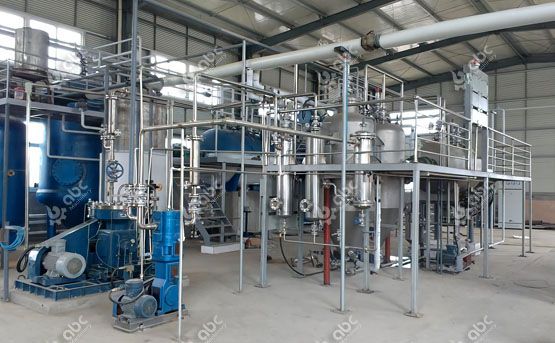
Ginkgo biloba (gingko, maidenhair tree) has a wide geographical distribustion, mainly distributed in China, Japan, Korea, Canada, New Zealand, Australia, USA, France and Russia.
With ginkgo nut or seed as raw material, subcritical butane as extraction solvent and oil yield of ginkgo seed as evaluation index, the subcritical extraction technology of ginkgo biloba oil was optimized by single factor experiment and orthogonal experiment. The results showed that the optimal subcritical extraction conditions of ginkgo biloba oil were obtained as follows:
- Extraction pressure: 0.5 MPa
- Extraction temperature: 40℃
- Extraction time: 60 min
- Ratio of material to liquid: 1:6
- Extraction times: 3
Under these conditions,the oil yield of ginkgo nut was 96.16%. The detection results of physicochemical properties of ginkgo oil indicated that the relative density is 0.9225, refractive index( 20℃) is 1.473 7, acid value is 1.95 mgKOH/g, iodine value is 156.62 gI/100 g, peroxide value is 1.46 mmol/kg, and saponication value is 181.19 mgKOH/g.
The Oil Yield of Ginkgo = Amounts of Ginkgo Oil Obtained by Subcritical Extraction/ Oil Content of Ginkgo x 100%
The fatty acid composition of ginkgo oil was analyzed by GC-MS and six kinds of fatty acids were identified as oleic acid ( 30.25%), linoleic acid ( 50.04%), palmitic acid ( 8.28%), octadecadienoic acid ( 2.34%), hexadecenoic acid( 4.41%) and eicosa-trienoic acid ( 4.67%), in which the content of unsaturated fatty acids was 91.71%.
Great Nutritional and Medical Value of Ginkgo
 Studies have shown that ginkgo not only rich in starch, protein, fat, vitamins and amino acids and other nutrients, also contain flavonoids, lactone and composition of lipids, and other functions. Besides, it is also famous for the functions of antibacterial and anti-inflammatory, improving cerebrovascular circulation, anti-cancer, anti-virus, antispasmodic, anti-allergy and beauty.
Studies have shown that ginkgo not only rich in starch, protein, fat, vitamins and amino acids and other nutrients, also contain flavonoids, lactone and composition of lipids, and other functions. Besides, it is also famous for the functions of antibacterial and anti-inflammatory, improving cerebrovascular circulation, anti-cancer, anti-virus, antispasmodic, anti-allergy and beauty.
The ginkgo nut or seeds contain 8%~10% oil. Ginkgo oil is a kind of oil with high nutritional value. Its unsaturated fatty acid content is above 85%, and the vast majority is oleic acid and linoleic acid. The development and utilization of ginkgo oil is promising!
Main Extraction Methods of Ginkgo Biloba Oil
At present, the main extraction methods of ginkgo biloba oil are organic solvent extraction and supercritical CO2 extraction.
- Traditional Organic Solvent Extraction: It takes a long extraction time, and requires a large amount of organic solvent (feed liquid ratio usually 1:10~1:20). It not only has high energy consumption, but also easy to remain solvent, and the pollution to the environment is also seriously.
- Supercritical CO2 Extraction: Supercritical CO2 extraction requires the addition of entrainer, and the extraction is required under high pressure. The extraction equipment is expensive, the production cost is high, and it also have difficulty in industrial production (only suitable for mini scale lab production).
- Subcritical Fluid Extraction: It is a new extraction and separation technology developed rapidly in recent years. It is carried out at a relatively low temperature, which can protect the thermal sensitive active ingredients in materials from being damaged. Compared with supercritical CO2 extraction method, it has the advantages of low extraction pressure, low operation cost and can be applied to industrialized ginkogo biloba oil production line.
See about the opration video: how our small subcritical oil extraction machine works?
Subcritical fluid extraction is seen as a green and promising new oil extraction technology, which has been well used in extraction of vegetable oil and essential oil including ginkgo biloba oil. (Our subcritical extraction machines are also widely used for Eucalyptus Oil Extracting and various Herbal Essential Oil Extracting Process)
Subcritical Ginkgo Biloba Oil Extraction Process
The technological process of subcritical ginkgo biloba oil extraction is shown below:

Subcritcial Gingko Oil Extraction Process Flow Chart
First, the fresh ginkgo nuts are processed by the full-automatic dehulling machine to separate the shell and kernel. Then, the ginkgo kernel will be freeze-dried and the moisture is controlled around 5%. Then, crushing the kernel into 40 mesh by crusher. Then, take a certain amount of the ginkgo kernel powder and pack it in 200 mesh filter bags and put the bags into the extraction tank. Then, the pressure in the extraction tank is reduced to 0.09Mpa by vacuum extraction. The extraction solvent butane is then imported into the extraction tank and the extraction starts.
After extraction, the extraction liquid is imported into separation tank with pressure pump. Then compressor is on, recovery and desolvation of extraction solvent is started. When the pressure of the separation tank and extraction tank falls below 0.15Mpa, start the vacuum pump until the pressure of the two tanks drops to 0.09Mpa. After desolventizing, the ginkgo biloba oil is collected and extracted by breaking vacuum and opening oil valve.
Single Factor Experiment of Subcritical Extraction of Ginkgo Oil
Influence of Extraction Times on Ginkgo Oil Yield
Set extraction pressure 0.5 MPa, extraction temperature 45 ℃, extraction time 60 min ,and solid-liquid ratio 1:6, extraction respectively 1, 2, 3, 4, 5 times. Take the oil yield as the evaluation index, to see the influences of extraction times on extraction efficiency of ginkgo biloba oil.

It can be seen that the oil yield of ginkgo oil increases with the increase of extraction times. Before extraction for 3 times, the oil yield increases rapidly. After extraction for 3 times, the oil yield reaches 95.56%. Taking production cost, oil yield and energy consumption into consideration, the optimum extraction times is 3.
Influence of Extraction Pressure on Ginkgo Oil Yield
Set extraction temperature 45 ℃, extraction time 60min, solid-liquid ratio 1:6, extract 3 times, extraction pressure control respectively 0.3, 0.4, 0.5, 0.6, 0.7MPa, with ginkgo oil yield as the evaluation index, to explore the effect of extraction pressure on ginkgo oil extraction effect.

As shown in the above Figure, the extraction pressure in the range of 0.3~0.5mpa, the oil yield increased rapidly with the increase of extraction pressure. This is because as extraction pressure increases, subcritical fluid density increases, its solubility increases, so oil yield increases. When the extraction pressure is 0.5MPa, the oil yield is increased to 95.86%, but when the extraction pressure exceeds 0.5MPa, the oil yield change is very small. The reason is that when the extraction pressure reaches a certain value, the solubility of extraction solvent butane to ginkgo oil tends to be saturated. When the pressure continues to increase, it has little effect on the mass transfer efficiency. Therefore, the optimum extraction pressure is around 0.5MPa.
Influence of Extraction Temperature on Ginkgo Oil Yield
Set the extraction pressure 0.5MPa, the extraction time 60min, the liquid ratio 1:6, the extract 3 times, the extraction temperature controlled respectively 30℃, 35℃, 40℃, 45℃, 50℃, to test the best extraction temperature of extracting Ginkgo biloba oil.

Increasing the extraction temperature can accelerate the thermal motion of solute and solvent molecules, increase the diffusion rate and solubility of solute, increase the extraction speed and oil yield. But too high extraction temperature will cause the decomposition destruction of heat-sensitive active components.
The above figure shows that when the extraction temperature is below 45 ℃, ginkgo oil yield efficiency increased dramatically with the temperature increasing of extraction. When extracting temperature 45 ℃, yield efficiency reaches to 95.89%, the peak. But when the extraction temperature is increased to 50 ℃, the oil yield went down to 89.43% instead.
On the one hand, the higher extraction temperature will cause the vaporization of solvent, decrease the density and increase the system pressure. On the other hand, the heat sensitive active ingredients in the material will be damaged by high temperature, thus resulting in lower oil yield. The optimum extraction temperature is 45 ℃ by comprehensive analysis.
Influence of Extraction Time on Ginkgo Oil Yield
Set extraction temperature 45 ℃, extraction pressure 0.5 MPa, material liquid ratio 1:6, extract 3 times, and extraction time was controlled to 30 min, 45 min, 60 min, 75 min and 90min respectively.

It takes time for oil to reach solution equilibrium in subcritical fluid, but excessive extraction time will increase energy consumption. As shown in the above figure, when extraction time was 30 ~ 60min, the oil yield of white fruit increased rapidly. This is because at the beginning of extraction, the solvent did not have good contact with the material. When extraction time was 60min, oil yield reached 96.01%. When extraction time was over 60min, white fruit oil yield tended to be balanced with the extension of extraction time. This is because the solubility of white ginkgo oil tends to be saturated in the extraction process, and the osmotic pressure of the extraction system also tends to be balanced. The amount of ginkgo biloba oil continued to be extracted is very small, making the oil yield tends to be stable. Taking all these into consideration, the optimal extraction time is selected as 60min.




